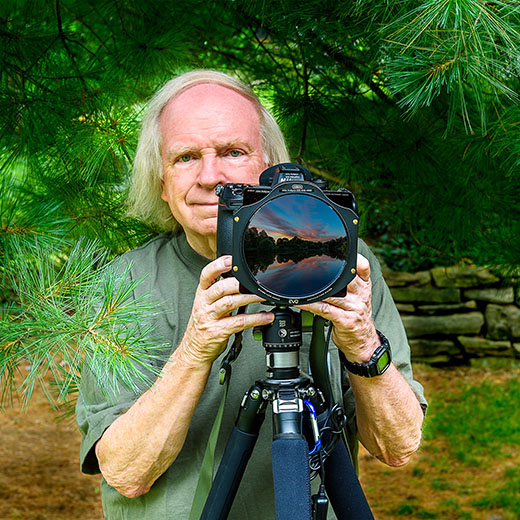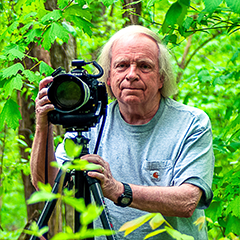
Cameras change frequently with new models introduced every year. It is hard to compete with all of the camera reviews and recommendations that are published throughout the year. So we won't.
However, we can make some general recommendations that you may find helpful. This is from a section of our book, Introduction to Digital Landscape Photography.
When choosing a camera for landscape photography, consider factors like megapixels, sensor size, and whether you prefer a DSLR or a mirrorless camera. More megapixels can produce greater detail and allow for larger prints, so you could start by looking for a camera in the 24MP to 60MP range. Larger sensors, like full-frame or medium format, capture more detail and enhance image quality, especially in low light. They also offer a greater dynamic range, which helps preserve details in shadows and highlights. DSLRs are known for their image quality, lens variety, durability, and longer battery life, while mirrorless cameras are typically smaller, more portable, and convenient, and they come with some advanced features.
Pixels are what photographs are made of. With more pixels, you have more room to crop your images, and you can produce larger prints of your images without losing detail. A 3 MP camera will give you a great 5x7” print at 300 DPI, while a 36 MP camera will provide a much larger 16x24” print at 300 DPI.
The type of camera you need depends on what you want to do with your images. If your images will be viewed primarily online, on a phone, or if you plan to make small prints, you probably don’t need more than a 12 MP camera. However, if you want to create spectacularly large prints, you need megapixels.
In landscape photography, you don’t need the processing speed required with sports or wildlife photography. With landscapes, you can typically afford to wait for a slow camera to buffer its image because it is unlikely you will need to rapidly fire your camera like you would with sports or wildlife. But speed can still be helpful.
Sensors come in a variety of sizes, from Micro Four Thirds to APS-C to Full Frame to Medium Format. Because Full Frame sensors don’t have a crop factor, they don’t magnify your lenses like smaller sensors do, making them better at capturing the wide angles you typically need for landscapes. They also provide a deeper dynamic range with less noise. However, full-frame cameras and lenses are larger and more expensive, while cameras with smaller sensors can be physically smaller and cheaper. While crop sensor cameras are not the best choice for landscapes, you are probably also interested in taking photographs of other subjects. If you are also going to use your camera to capture wildlife, a crop sensor camera will bring you closer to your subject and enlarge it, which isn’t something you typically want with a landscape.
The size and weight of your camera will also influence what you can do with it. If a lightweight setup is important to you, especially if you will be backpacking long distances, then a mirrorless APS-C or a micro 4/3 camera may be a better choice.
Since we are shooting digitally, you need to pay attention to the camera’s battery life. If you will be backpacking for long trips, you may need to carry extra batteries, a power bank, or a small solar panel to recharge those batteries out in the wilderness.
It often rains when you are taking landscape photographs. Waterproof cameras are completely sealed, but they are very expensive. More common are weatherproof cameras, although their degree of protection varies widely. The degree you need depends on what activity you will be doing. If you anticipate lengthy backpacking trips where you will be outside in the elements for extended periods, then invest in a more rugged system.
Camera design is also an important consideration. A camera performs better if it feels comfortable in your hands. Is bracketing important to you? How about HDR? Do you need rear-button focus, or will shutter button focus work just as well for you? These are all things to consider when deciding on a camera.
Both DSLR and mirrorless cameras have their own strengths and weaknesses regarding landscape photography. While DSLRs are renowned for their exceptional image quality, lens selection, longer battery life, and durability, mirrorless cameras offer portability, convenience, and some advanced features. Full-frame cameras don't produce better-looking photographs — they produce larger ones, and their Raw files are enormous with massive resolution. In landscape photography, the primary reason for high resolution is to routinely make large prints, so you'll probably find it worthwhile to invest in those extra megapixels within a 24MP to 60MP range.
Older digital cameras can still capture beautiful landscape photographs. The quality of digital photographs has not changed much in the past 20 years, although certain camera features have greatly improved. I really appreciate the focus tracking that my newer camera can perform when shooting wildlife, but the actual quality of the photo isn’t necessarily better. That being said, I do believe I get higher quality photos from the larger resolution and greater dynamic range that comes with a larger camera sensor. Older cameras can still produce stunning landscape photographs, and if an older camera fits your budget better, then rest assured that an older camera can still do a wonderful job, particularly with landscapes.
When choosing a lens for landscape photography, consider factors like focal length and weather sealing. Wide-angle lenses, such as 24-70mm or 14-24mm, work well for landscape photography because they provide a wide field of view and a deep depth of field. I take most of my landscape photographs with my NIKKOR Z 24-70mm ƒ/2.8 S Lens. If you enjoy shooting outdoors, a lens with weather sealing can be very beneficial. I wouldn’t trust any camera in a downpour, but cameras can easily become moist outdoors, so having weather sealing for all seasons is smart.
A wide-angle zoom lens along with a telephoto zoom lens (such as a 70-200mm), are two lenses that I frequently carry together when I am out hiking. These two focal lengths cover a wide variety of situations, from vast expansive vistas to more abstract and intimate close-up shots of landscape features.
]Many photographers may not consider a telephoto lens suitable for landscape photography, but they enable you to isolate objects and details within the landscape with a much narrower depth of field. You can zoom in on lines, patterns, layers, textures, and even silhouettes for more abstract images, or when faced with a scene that lacks an interesting foreground or background, particularly a gray sky.
If I have the room, I also carry a macro lens, especially during wildflower season. Macro lenses can reproduce subjects at their actual size or larger and capture a high level of detail. When backpacking, I often use my 105mm macro lens to photograph plants or details found in old structures or foundations.
Macro lenses, while not typically a first choice for landscape photographers, can be quite versatile. You can use a macro lens to photograph a scenic vista and then quickly get close to the ground to take a photo of a flower or another small detail without changing lenses.
